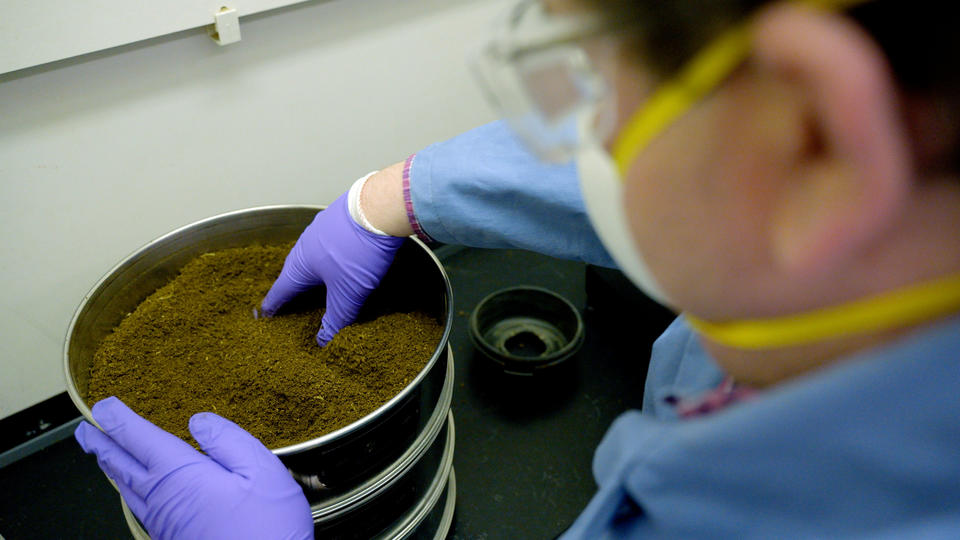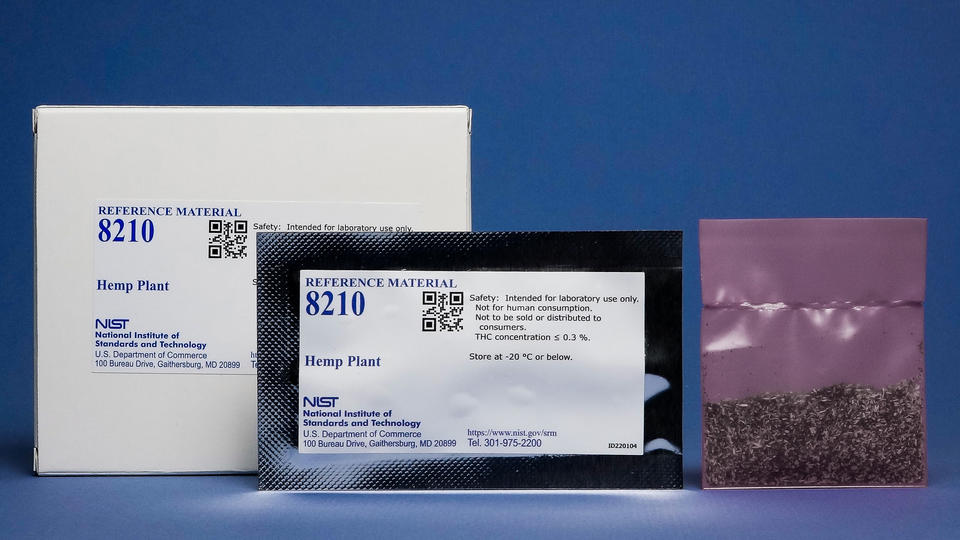- NIST’s Hemp Plant Reference Material will help labs accurately measure the amount of THC, CBD, toxic elements and other compounds in cannabis products.
- This will help forensic labs correctly determine whether a seized material is hemp, which is legal in all 50 states, or marijuana, which is a controlled substance under federal law.
- It will also help producers and state regulators ensure that cannabis products are safe to use and accurately labeled.

NIST chemist Brent Wilson passes ground hemp through a sieve to produce a reference material with a consistent particle size.
The National Institute of Standards and Technology (NIST) is now selling a hemp reference material that will help laboratories accurately measure key components in cannabis plant products. This will help law enforcement agencies accurately distinguish between hemp and marijuana and will help manufacturers and regulatory agencies ensure that cannabis products are safe and accurately labeled.
Hemp and marijuana both come from the Cannabis plant. Before 2018, all cannabis plant material or products were controlled substances under federal law. The 2018 Farm Bill legalized hemp, which it defined as any cannabis material with 0.3% total THC or less. Cannabis with more than that amount of total THC is considered marijuana and is still a controlled substance under federal law.
This means that, to determine whether a material is a controlled substance, labs now have to measure the amount of total THC in it. However, recent studies, including one by NIST researchers, have found that THC measurements as shown on product labels are not consistently reliable, causing potentially serious safety and regulatory challenges.
The new hemp material from NIST will help address this issue by serving as a reference material — that is, a material that labs use to ensure the accuracy of their measurements.
The NIST Hemp Plant Reference Material (RM 8210) comes with an information sheet listing the precise amounts of total THC, CBD (a nonintoxicating compound with purported health benefits) and several toxic elements sometimes found in agricultural products, along with uncertainty estimates for each.
To ensure that their measurement methods are working properly, labs can analyze a bit of this material. If their numbers match those from NIST to within an accepted margin of error, all is well. If not, they’ll know they need to recalibrate their instruments or otherwise troubleshoot their methods.
“A farmer’s crop or a company’s product can be seized or potentially destroyed if it turns out to be a ‘hot’ material, so it’s important to make the correct determination,” said Walter Brent Wilson, one of the NIST chemists who developed the new reference material. Hemp, grown as an agricultural crop, is often used to manufacture textiles, paper and food products.
Although this reference material is composed of hemp, labs can use it to validate their measurements of both hemp and marijuana, and it will help companies in the fast-growing cannabis industry and state regulators ensure that cannabis products are safe and accurately labeled.
“If you buy a product that claims to have 25 milligrams of CBD per dose, you should be able to trust that number,” said NIST biologist Colleen Bryan, who was also on the team that developed the reference material.
The NIST material also includes measurements for arsenic, lead, mercury, cadmium and other toxic elements that many agricultural products get tested for.
“People who use cannabis for medical reasons may be particularly concerned about safety,” Bryan said. “This reference material will help ensure that the cannabis they buy does not contain unsafe levels of toxic elements.”

The NIST hemp reference material will also include measurements for moisture content. This is important because it will help labs accurately report the amounts of THC and other substances on a dry-weight basis, which is how most regulatory limits are defined.
Finally, the new material from NIST will help researchers who study the health and other effects of cannabis to accurately measure the dosages used in their studies. This will allow researchers to compare results across studies more easily.
Laboratories use reference materials all the time. NIST produces more than a thousand of them. Reference materials such as peanut butter, spinach and infant formula are used to ensure food safety and accurate nutrition labels. You can trust the results of your blood test because of NIST reference materials such as cholesterol, glucose and vitamin D. Environmental contaminants, atmospheric gases, construction materials — the list goes on and on.
NIST’s hemp reference material was made from commercially purchased dried hemp. To make it, NIST researchers ground the hemp, sieved it to achieve a consistent particle size, blended a bit of lower-THC material into it to achieve a total THC concentration just below the legal threshold, and measured the amounts of the various components to a very high degree of accuracy and precision. Finally, NIST statisticians analyzed the measurement results to estimate the uncertainty values for each measurement.
Each unit of the material contains three packets with 1.5 grams each of ground hemp — some of the most carefully quantified cannabis ever sold.
Beyond the Hemp Plant Reference Material, NIST leads multilaboratory studies aimed at helping labs achieve accurate cannabis measurements. In addition, with funding from the National Institute of Justice, NIST is developing improved laboratory methods for measuring THC and other cannabinoids and is researching the feasibility of an accurate THC breathalyzer.

